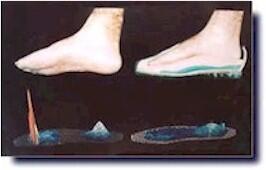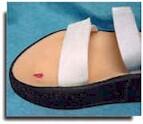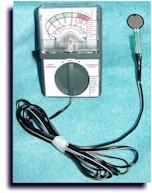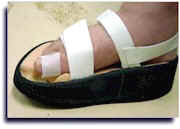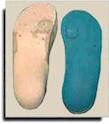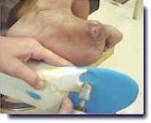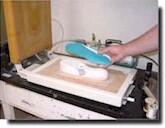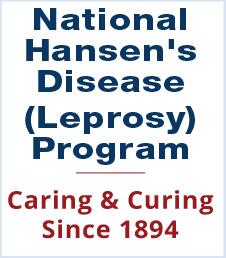The choice of orthotics should be determined by the supportive and protective needs of the foot and not by the style of the shoe. Shoe selection should be subsequent to orthotic need. The options for orthotic design and materials, like footwear, depend on the condition of plantar skin integrity (scar tissue), foot deformity and patient activity level. The desired effect of a molded orthotic is to increase the surface area in contact with the foot thereby distributing the forces of walking more evenly and reducing high pressure from any one area. A wide selection of materials are available for orthotic fabrication and most offer many of the same qualities. With fabrication experience comes a bias for a material or a combination of materials that gives the desired results of maintaining ulcer closure. Keep in mind the shoe must be able to accommodate an orthotic.
The choice of orthotic support can be referenced as follows:
| Symptoms | Appropriate Orthotic Support | Image |
|
Loss of protective sensation No toe or foot deformity |
Non-molded soft orthotic (Spenco or Poron) |
 |
|
Loss of protective sensation Mild to moderate toe or foot deformity |
Soft custom molded orthotic semi-functional/ accommodative soft material |
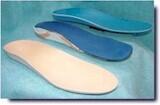 |
|
Loss of protective sensation Moderate to severe deformity History of plantar ulceration History of Charcot fracture |
Soft contoured molded orthotic Multiple densityPurely accommodative Added relief areas |
 |
The fitting of orthotics is very important. Without sensory feedback to warn of imminent injury from ill fitting shoes/orthotics, increased attention is needed to assure proper fit. Minute ridges, wrinkles, lumps or bumps induced in a custom molded orthotic or footbed of any type can be detrimental to an insensitive foot. Additionally, relief placement can and should be monitored for accuracy with some type of measurement tool. The example shown is a plantar pressure map with and without an orthotic. The upward deflections, or peaks, are signs of very high pressure. Note the change in pressure distribution with the molded orthotic.
|
Plantar pressure map with and without an orthodontic. |
Other simple devices may be used with sufficient effectiveness (i.e. lipstick and a single pressure sensory device). |
|
A single pressure sensory device. |
Great toe relief cutout. |
Molded orthotics are usually vacuum pressed requiring a plaster model of the patient's foot. During preparation of the positive model, build-ups may be added to provide additional pressure relief. Once an orthotic has been fabricated and trialed, some high pressure areas may still exist. Local spot relieving by a handheld grinder or the adding of material to create relief may be needed to ensure appropriate protection.
|
Positive mold with build-ups and orthotic with relief. |
Local spot relieving with hand held grinder. |
Vacuum press machine with plaster model of patient's foot. |
With every new orthotic and/or shoe dispensed, the patient and health care professional should monitor the feet very closely for signs of redness, callus, swelling, pre-ulceration or recurrence of a previous ulcer. Immediate attention given to signs of pressure will help prevent reulceration.




